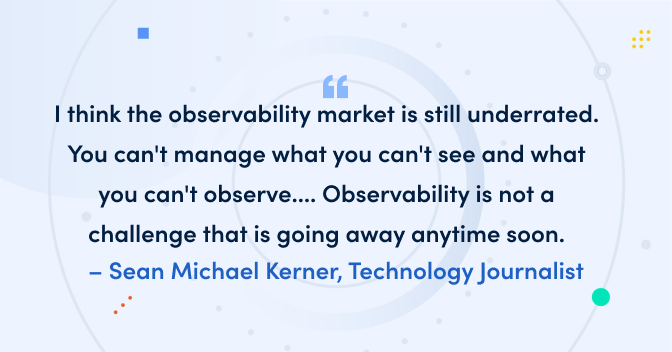
The observability market is heating up, but is it more than just hype? Industry watchers weigh in
The observability market is undoubtedly hot. Consider the headline-grabbing evidence: multiple IPOs, hundreds of millions of dollars in venture capital funding for startups, and huge market caps of vendors playing in the space totalling more than $80 billion. Still, it has to be asked: Is all the hype warranted, or is this really just “absurdability”? We asked seven industry watchers to weigh in.
James Governor, Analyst & Co-founder, Redmonk
In 2020 Observability made the transition from being a niche concern to a new frontier for user experience, systems and service management in web companies and enterprises alike. Technology providers in the Application Performance Monitoring (APM), Log Management, and Distributed Tracing categories are all positioning themselves as Observability plays this year.
The primary driver behind the Observability trend is that, simply, there is a lot more uncertainty in systems and applications than there used to be. Distributed systems are by definition non-deterministic. What is more, change, rather than stability, is now the goal. Where a team used to ship a new version perhaps once a year, and had plenty of time to model its failure modes, the expectation is now for weekly or even daily feature deployments. Modern applications by design have multiple, changing, failure modes – “unknown unknowns” if you like – which means new approaches to management. Troubleshooting for and by developers is key to system performance and rapid recovery from failure.
Observability allows us to experiment, to test in production, to take a Progressive Delivery approach where we watch a system in production before deploying it more widely. It is indeed a big deal.
Sean Michael Kerner, Technology Journalist
I think the observability market is still underrated. You can’t manage what you can’t see and what you can’t observe. There is so very much complexity and nuance in the modern IT world with a mix of legacy, cloud, virtualized, cloud native, microservices (insert buzzword here) across a distributed landscape, and observability is not a challenge that is going away anytime soon.
Ethan Banks, Co-founder, Packet Pushers
The observability market is growing because of the incredible complexity of application delivery systems. Multi-layered software stacks ride on multi-layered and often ephemeral infrastructure stacks. Dev and ops teams used to be able to keep up with stack interactions, but that’s a hopeless task in the modern era. Smartly deployed observability platforms fill in the gap, helping businesses get to the root cause of outages quickly to maintain their competitive edge.
Chris Preimesberger, Editor, eWEEK
I’m not going to contend that there’s “hype” as such, but the observability market is definitely one that’s gaining gravitas lately. Enterprises are losing security control of many of their distributed processes and applications, due especially to the impact of the pandemic and remote employees, partners and customers. Wavefront by VMware is one platform getting some traction here, as are Dynatrace, Splunk, Google, and some others. It’s a trend that’s here to stay because things aren’t getting any simpler.
Jason Bloomberg, President, Intellyx
Cloud native observability is not only relevant to organizations that are implementing Kubernetes. As cloud native computing represents a paradigm shift in enterprise IT, the observability part of the story also reflects new ways of leveraging technology to manage increasingly complex IT infrastructure.
Alan Shimel, CEO, MediaOps
Observability is certainly a hot word in the industry today. But for me it is a new word to describe an old problem. In the IT industry for a long time, we have been on a quest for “actionable intelligence.” It is not enough to just gather information or to have information stored away somewhere. How do we filter all of the data to turn it into actionable intelligence? Can that action be automated, or does it have to have a human to act on it? To me that is the promise of Observability and why beyond the hype it is a very real, important part of today’s IT landscape.
Gaurav Gupta, Partner, Lightspeed Venture Partners
Every vendor claims to “do it all” – it feels impossible for anyone to cut through the marketing hype. That said, customer pain continues to get worse, and cloud and microservice-based architectures can sometimes be a blessing in disguise, because they make it incredibly hard to troubleshoot a system. I believe open source vendors like Grafana (and Elastic) will ultimately win the day. Their modular and open architecture enables these products to support best-of-breed approaches, which customers are quickly realizing is the only viable path forward.
Conclusion
When a market is this hot, it’s hard not to question whether there’s too much hype. But these experts agree that the pain of troubleshooting complex, distributed systems is very real – and so is the need for solutions that align to the needs of organizations instead of the desires of vendors. As such, the observability market is not just here to stay, but it’s also only going to get bigger.
